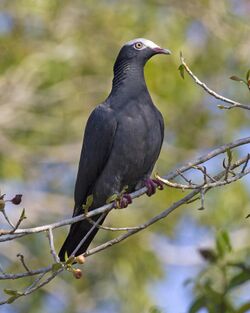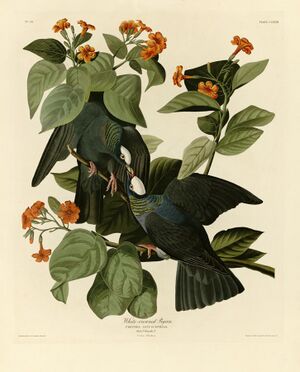Biology:White-crowned pigeon
| White-crowned pigeon | |
|---|---|

| |
| In Florida, USA | |
| Scientific classification | |
| Domain: | Eukaryota |
| Kingdom: | Animalia |
| Phylum: | Chordata |
| Class: | Aves |
| Order: | Columbiformes |
| Family: | Columbidae |
| Genus: | Patagioenas |
| Species: | P. leucocephala
|
| Binomial name | |
| Patagioenas leucocephala | |

| |
| Synonyms | |
The white-crowned pigeon (Patagioenas leucocephala) is a fruit and seed-eating species of bird in the dove and pigeon family Columbidae. It is found primarily in the Caribbean.
John James Audubon painted these pigeons, including the watercolour painting in his work, Birds of America, published in the early 19th century.
Taxonomy
In the first half of the 18th century the white-crowned pigeon was described and illustrated by several naturalists including John Ray in 1713,[3] Hans Sloane in 1725[4] and Mark Catesby in 1731.[5] When in 1758 the Swedish naturalist Carl Linnaeus updated his Systema Naturae for the tenth edition, he placed the white-crowned pigeon with all the other pigeons in the genus Columba. Linnaeus included a brief description, coined the binomial name Columba leucocephala and cited the earlier authors.[6] The specific epithet combines the Ancient Greek leukos meaning "white" and -kephalos meaning "-headed".[7] Although Linnaeus gave the location as North America, the type locality is taken to be the Bahamas following Catesby.[8] The species is now placed in the genus Patagioenas that was introduced by the German naturalist Ludwig Reichenbach in 1853 with the white-crowned pigeon as the type species.[9][10] The species is monotypic: no subspecies are recognised.[10]
Description
The white-crowned pigeon can measure 29–35 cm (11–14 in) in length, span 48–59 cm (19–23 in) across the wings, and weigh 150–301 g (5.3–10.6 oz). It is around the same size as the common rock pigeon, but weighs a bit less since it is generally less chunky and has a relatively longer and more square tail.[11] Adult birds' plumage varies from a slate gray to an almost-black color. Its iridescent collar-patch is notably only seen under good lighting, shining a barred white pattern with green. Their distinct crown-patch can vary in shade of color from a more bright white in males to a more gray-white in most females.[12] Juveniles can have a grayish-brown color for They have a white iris and a pale-tipped red bill. Juveniles are a less dark shade of grey, lack the nape pattern and white iris, and show only a few pale feathers on the crown. Their call is a loud, deep coo-cura-coo or coo-croo. This species is a member of a diverse clade of Patagioenas which vary much in appearance, but are united by their triple coos (except in the scaled pigeon).[13][14]
Distribution and habitat
It is a resident breeder mainly in the Bahamas, Cuba, Jamaica and Antigua. It breeds in smaller numbers in Hispaniola (the Dominican Republic and Haiti), Puerto Rico, the Virgin Islands, the Cayman Islands, Anguilla and other Caribbean islands. It also breeds along the Caribbean coast of Central America. In the United States , it is found only in the Florida Keys, Everglades, and the southern tip of mainland Florida.[15] They will often spend the winter in the Caribbean islands.
The white-crowned pigeon primarily lives and breeds in nest colonies or individually in low lying, coastal, mangrove forests, and will travel inland to feed on the fruits and seeds of a wide variety of plants. In Florida, the white-crowned pigeon has historically been documented nesting exclusively on remote, tidally inundated mangrove islands in wildlife refuges. Recent observations have confirmed nesting on the southern tip of mainland Florida.[16]
With few exceptions, this species requires isolated offshore mangrove islets with limited disturbance for breeding.[15] These tidally inundated mangrove islands which provide some protection from predators such as raccoons. However, several instances of white-crowned pigeons nesting in heavily trafficked, urban areas, such as downtown Key West and Miami Florida, have recently been observed. This could be due to habitat loss as a result of hurricanes, and/or increased predation pressure in their historic nesting habitat.[16]
Threats and conservation
A main threat to this species is loss of habitat due to deforestation and habitat degradation. The white-crowned pigeon needs two distinct habitats: one for nesting and one for feeding. They typically breed in coastal red mangroves (Rhizophora mangle), which continue to be clear-cut for crops such as sugarcane. Agriculture and deforestation have become a problem for the species' feeding grounds, typically inland hardwood forests. The bird is very skittish, and is known to simply abandon its nest when it is encroached upon. In Florida, white-crowned pigeons often feed on the fruit of poisonwood (Metopium toxiferum). Unfortunately, this native plant causes severe human dermatitis and is often removed.
The white-crowned pigeon is also hunted, often illegally, throughout much of its range. Although, changes have been made to hunting regulations in the Bahamas, illegal hunting is still a problem for these pigeons.
Other threats to this species include (in Florida) a major cause of mortality is collision with man-made objects; and pesticide use.[15]
Like the extinct passenger pigeon, this species illustrates a very important principle of conservation biology: it is not always necessary to kill the last pair of a species to force it to extinction. These birds are "threatened by the slaughter of nesting birds on its Caribbean breeding grounds"; they may play a vitally important, yet not fully understood, role in the seed dispersal of West Indian flora.[17]
References
- ↑ BirdLife International (2020). "Patagioenas leucocephala". IUCN Red List of Threatened Species 2020: e.T22690229A178283762. doi:10.2305/IUCN.UK.2020-3.RLTS.T22690229A178283762.en. https://www.iucnredlist.org/species/22690229/178283762. Retrieved 19 November 2021.
- ↑ "NatureServe Explorer 2.0". https://explorer.natureserve.org/Taxon/ELEMENT_GLOBAL.2.101675/Patagioenas_leucocephala.
- ↑ Ray, John (1713) (in Latin). Synopsis methodica avium & piscium. London: William Innys. p. 184. https://www.biodiversitylibrary.org/page/6355450.
- ↑ Sloane, Hans (1725). A Voyage to the Islands Madera, Barbados, Nieves, S. Christophers and Jamaica : with the natural history of the herbs and trees, four-footed beasts, fishes, birds, insects, reptiles, &c. of the last of those islands. 2. London: Printed for the author. p. 303, Plate 261. https://www.biodiversitylibrary.org/page/188474.
- ↑ Catesby, Mark (1729–1732) (in English, French). The Natural History of Carolina, Florida and the Bahama Islands. 1. London: W. Innys and R. Manby. p. 25, Plate 25. https://www.biodiversitylibrary.org/page/40753193.
- ↑ Linnaeus, Carl (1758) (in Latin). Systema Naturae per regna tria naturae, secundum classes, ordines, genera, species, cum characteribus, differentiis, synonymis, locis. 1 (10th ed.). Holmiae:Laurentii Salvii. p. 164. https://www.biodiversitylibrary.org/page/727071.
- ↑ Jobling, James A. (2010). The Helm Dictionary of Scientific Bird Names. London: Christopher Helm. p. 223. ISBN 978-1-4081-2501-4. https://archive.org/details/helmdictionarysc00jobl.
- ↑ Peters, James Lee, ed (1937). Check-List of Birds of the World. 3. Cambridge, Massachusetts: Harvard University Press. p. 62. https://www.biodiversitylibrary.org/page/14477777.
- ↑ Reichenbach, Ludwig (1853) (in German). Handbuch der speciellen Ornithologie. Leipzig: Friedrich Hofmeister. p. xxv. https://www.biodiversitylibrary.org/page/47618655.
- ↑ 10.0 10.1 Gill, Frank; Donsker, David; Rasmussen, Pamela, eds (2020). "Pigeons". IOC World Bird List Version 10.1. International Ornithologists' Union. https://www.worldbirdnames.org/bow/pigeons/.
- ↑ Gibbs, David, Pigeons and Doves. A&C Black (2001), ISBN:978-1-873403-60-0
- ↑ Dunn, Jonathan (2011). Birds of North America. Washington, D.C.: National Geographic. pp. 264. ISBN 978-1-4262-0828-7.
- ↑ Johnson, Kevin P.; de Kort, Selvino; Dinwoodey, Karen; Mateman, A. C.; ten Cate, Carel; Lessells, C. M.; Clayton, Dale H. (2001). "A molecular phylogeny of the dove genera Streptopelia and Columba". Auk 118 (4): 874–887. doi:10.1642/0004-8038(2001)118[0874:AMPOTD2.0.CO;2]. http://www.inhs.uiuc.edu/~kjohnson/kpj_pdfs/Auk.2001.pdf.
- ↑ Mahler, Bettina; Tubaro, Pablo L. (2001). "Relationship between song characters and morphology in New World pigeons". Biological Journal of the Linnean Society 74 (4): 533–539. doi:10.1006/bijl.2001.0596.
- ↑ 15.0 15.1 15.2 "White-crowned Pigeon". http://datazone.birdlife.org/species/factsheet/white-crowned-pigeon-patagioenas-leucocephala/text.
- ↑ 16.0 16.1 Zambrano, Ricardo (2017). "New Records of WhiteCrowned Pigeon Nesting in Urban Key West and Miami, Florida". Urban Naturalist 13. https://www.eaglehill.us/urna-pdfs-regular/pdfs-URNA-13/05%20U128%20Zambrano%20complete.pdf.
- ↑ Ehrlich, Paul R.; Dobkin, David S.; Wheye, Darryl (1988). "The Passenger Pigeon". Stanford University. http://www.stanford.edu/group/stanfordbirds/text/essays/Passenger_Pigeon.html.
External links
| Wikimedia Commons has media related to Patagioenas leucocephala. |
Wikidata ☰ Q1269998 entry
 |




